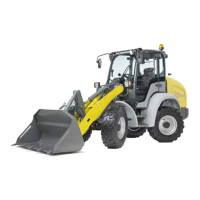2-6 BA 357-00 * 3.0 * Sicherheit_E.fm
2 Safety
Job site
• The operator is responsible for other persons.
• Before starting work, familiarize yourself with the job site.
This applies to, for example:
- Obstacles in the job site and machine travel area,
- any barriers separating the job site from public roads,
- soil weight-bearing capacity,
- existing overhead and underground lines,
- special operating conditions (for example dust, steam, smoke,
asbestos).
• The operator must know the maximum dimensions of the machine and
the attachment – see chapter “Technical data”.
• Maintain a safe distance (for example, from buildings, edges of
building pits).
• During work in buildings or in enclosed areas, look out for:
- Height of the ceiling/clearances
- Width of entries/passages
- Maximum load of ceilings and floors
- Sufficient room ventilation
• Use existing visual aids to stay aware of the danger zone.
• In conditions of darkness and poor visibility, switch on existing work
lights and ensure that motorists are not blinded by these lights.
• If the existing lights of the vehicle are not sufficient for performing work
safely, ensure additional lighting of the job site.
• Due to hot machine parts, maintain a safe distance from easily
flammable material (for example, from hay, dry leaves).
Danger zone
• The danger zone is the area in which persons are in danger due to the
movements of the machine, attachment and/or load.
• The danger zone also includes the area that can be affected by falling
material, equipment or by parts that are thrown out.
• Extend the danger zone sufficiently in the immediate vicinity of
buildings, scaffolds or other elements of construction.
• Seal off the danger zone should it not be possible to keep a sufficient
safety distance.
• Stop vehicle operation immediately if persons do not stay clear of the
danger zone.

